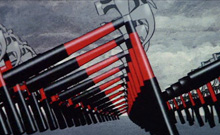Another form of traditional animation is live action animation in which traditional hand-drawn animation is combined with real live-action filming. Techniques for doing this include optical printers or aerial image animation cameras, or more labour intensively, tracing each frame with a method known as rotoscoping to enable more accuracy when overlaying frames. One of the earliest examples includes Winsor McCay’s Gertie the Dinosaur (1914) in which a real actor played a narrator who interacted with an animated landscape and dinosaur character.
Live-action animation is another powerful tool for manipulating reality, especially because it combines reality with non-reality. While one can believe they are watching a scene they are familiar with, the familiarity is thrown off as the animated elements are brought into the scene.
Pink Floyd The Wall (1982), although the majority being normal live-action film work, contains segments of both full animation and live-action animation, drawn by illustrator Gerald Scarfe. The detailed animation sequences are similar to Paprika in the use of traditional hand-drawn techniques, although completely different in medium and style. The live-action animation scene happens when Pink is alone in his room and is ‘attacked’ by an animated plant. The reality of Pink alone in the room is almost immediately distorted upon the human shadow morphing into something else, implying a departure from reality and highlighting the alienation of Pink from the rest of the world.
In terms of the traditional animated scenes in The Wall, there is obviously a form of manipulation in the exaggerated (and simplified) characteristics of flowers, facial expressions and the human body. The animations serve to let viewers interpret the story and the metaphor of the wall. For example, the revisited scene of the teacher ‘educating’ his students presents an alternative perspective of the scene for the viewer, manipulating the what was previously seen into something even more wild and disproportional.











